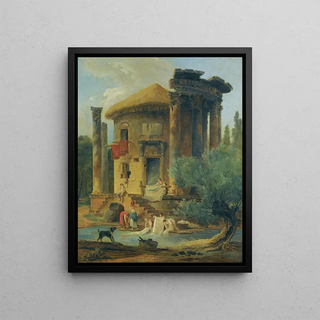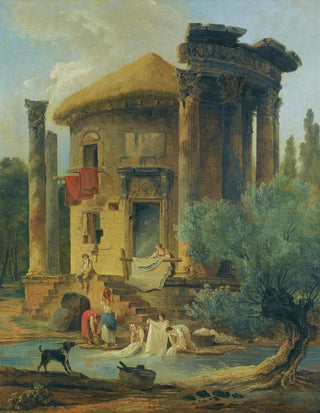Art print | Washerwomen by a riverbank beneath a ruined circular temple - Hubert Robert


View from behind

Frame (optional)
In the panorama of 18th-century art, a work stands out for its ability to capture the fleeting beauty of nature while evoking nostalgia for bygone times. "Lavandières au bord d'une rivière sous un temple circulaire en ruine - Hubert Robert" transports us to a world where the daily life of washerwomen blends with the grandeur of architectural ruins. This painting, imbued with a bucolic atmosphere, invites the viewer to contemplate not only human activity but also the majesty of a glorious past, now erased. The scene, bathed in soft light, serves as an ode to the simplicity and beauty of female labor, while incorporating elements of nature that seem to dance to the rhythm of the water.
Style and uniqueness of the work
Hubert Robert's work is characterized by a delicate harmony between landscape and architecture. In "Lavandières au bord d'une rivière sous un temple circulaire en ruine," the choice of pastel colors and the fluidity of forms create a serene and soothing atmosphere. The washerwomen, central figures of the composition, are depicted with precision that highlights their essential role in daily life, while also giving them an almost mythological dimension. The circular temple in ruins, in the background, evokes the grandeur of an ancient past, reminding us both of the fragility of human existence and the permanence of nature. The juxtaposition of these elements creates a captivating visual dialogue, where the artist manages to fuse the real and the sublime, offering the viewer an immersive and contemplative experience.
The artist and his influence
Hubert Robert, nicknamed "Robert des ruines," is an emblematic artist of the Rococo movement, recognized for his passion for landscapes and ancient architectures. His work is marked by a fascination with ruins, symbols of the passage of time and fleeting beauty. Influenced by his travels in Italy, Robert was able to incorporate elements of classical culture into his compositions, while adapting them to a contemporary sensibility. His innovative approach paved the way for many artists, inspiring generations to explore the relationship

Matte finish

View from behind

Frame (optional)
In the panorama of 18th-century art, a work stands out for its ability to capture the fleeting beauty of nature while evoking nostalgia for bygone times. "Lavandières au bord d'une rivière sous un temple circulaire en ruine - Hubert Robert" transports us to a world where the daily life of washerwomen blends with the grandeur of architectural ruins. This painting, imbued with a bucolic atmosphere, invites the viewer to contemplate not only human activity but also the majesty of a glorious past, now erased. The scene, bathed in soft light, serves as an ode to the simplicity and beauty of female labor, while incorporating elements of nature that seem to dance to the rhythm of the water.
Style and uniqueness of the work
Hubert Robert's work is characterized by a delicate harmony between landscape and architecture. In "Lavandières au bord d'une rivière sous un temple circulaire en ruine," the choice of pastel colors and the fluidity of forms create a serene and soothing atmosphere. The washerwomen, central figures of the composition, are depicted with precision that highlights their essential role in daily life, while also giving them an almost mythological dimension. The circular temple in ruins, in the background, evokes the grandeur of an ancient past, reminding us both of the fragility of human existence and the permanence of nature. The juxtaposition of these elements creates a captivating visual dialogue, where the artist manages to fuse the real and the sublime, offering the viewer an immersive and contemplative experience.
The artist and his influence
Hubert Robert, nicknamed "Robert des ruines," is an emblematic artist of the Rococo movement, recognized for his passion for landscapes and ancient architectures. His work is marked by a fascination with ruins, symbols of the passage of time and fleeting beauty. Influenced by his travels in Italy, Robert was able to incorporate elements of classical culture into his compositions, while adapting them to a contemporary sensibility. His innovative approach paved the way for many artists, inspiring generations to explore the relationship






